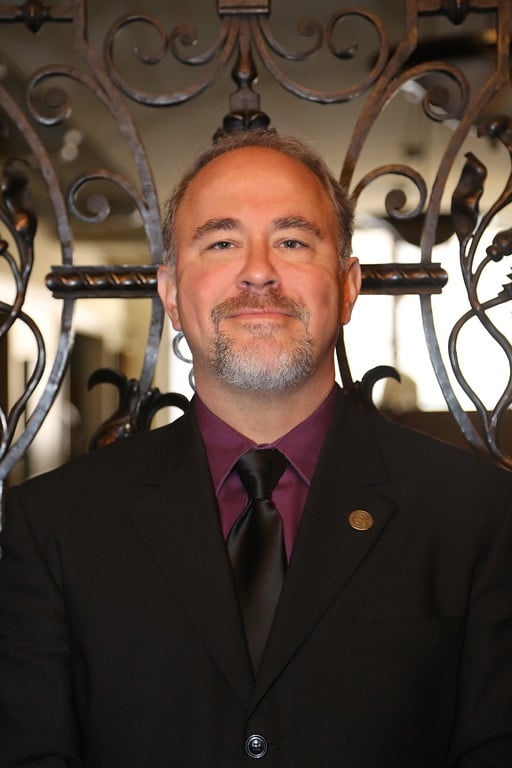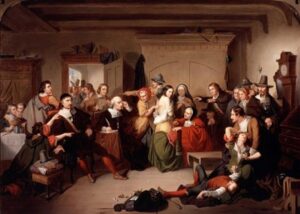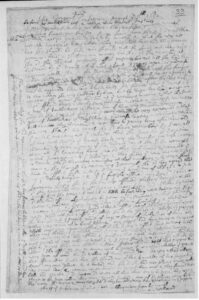For some in Massachusetts, the mention of the years 1692 and 1693 still reminds us of a very dark and regrettable chapter in our past – a past that still is being written, analyzed, and researched more than three centuries later. The regrettable set of events that unfolded 330 years ago resulted in what we know in American history as the Salem Witchcraft trials. Alive today are countless descendants of those accused of and executed for witchcraft, as well as their accusers, and the judges who passed judgment based on spectral evidence.
From my own early genealogical research, I discovered while still in junior high school that my great-great-great-great-great-great-great-great-great-great-grandmother Mary (Perkins) Bradbury (1615-1700) of Salisbury, Massachusetts, was an accused witch. She was one of the lucky ones, however, and escaped her execution. Many still ponder whether Mary or her husband Thomas Bradbury bribed the jailor and made it possible for her to vanish into the New England frontier until after the witchcraft hysteria subsided. Often facts like these are lost to history but continue to make us dig and reinvestigate this chapter in colonial New England. As genealogists and historians, we are extremely fortunate to have surviving records from the trials preserved in various archives and available to be discovered digitally online.
In the early eighteenth century, the colony offered financial compensation to many of those accused or their survivors. In 1957, the Commonwealth of Massachusetts officially apologized for the role it played in the Salem Witchcraft trials and pardoned those accused and executed wrongfully so long ago. One accused witch who was pardoned in 1957 was Elizabeth Johnson Sr. of Andover, Massachusetts. Her daughter Elizabeth Johnson Jr., also accused of witchcraft, was never officially pardoned … until 2022.
That effort was accomplished in part by the research of junior historians in an eighth-grade civics class at the North Andover Middle School. They worked with Massachusetts lawmakers, and in May 2022 their efforts finally exonerated Elizabeth Johnson Jr., 329 years after she had been accused of witchcraft in 1693. (Perhaps she was overlooked simply because her mother was also named Elizabeth Johnson.) My natural curiosity got the best of me about who the last exonerated accused Salem witch was, and did she in fact have any living descendants?
Elizabeth Johnson Jr. was the daughter of Stephen and Elizabeth (Dane) Johnson of Andover, who were married there on 5 November 1661. Elizabeth’s own date of birth cannot be located, but based upon her age from trial records she would have been born ca. 1671. The search for her living descendants ended as quickly as it began, as I discovered she died unmarried at Andover 3 January 1746/47.
Elizabeth’s mother Elizabeth Dane was the daughter of the Rev. Francis Dane (1615-1697), who settled as a minister in Andover in 1648. It is almost unthinkable that the daughter and granddaughter of a seated minister would be accused of witchcraft, but they were, as would be other members of Dane’s family. Francis Dane was first married to Elizabeth Ingalls, the daughter of Edmund Ingalls (1598-1648) of Lynn, Massachusetts. Rev. Dane’s niece was Martha Carrier – the daughter of Andrew and Faith (Ingalls) Allen, and granddaughter of Edmund Ingalls – who was executed during the hysteria on 19 August 1692. Discovering the Ingalls connection is when I realized that Elizabeth Johnson Jr. and I shared a common ancestry. This makes her my second cousin nine times removed, and the distant cousin of former U.S. President James A. Garfield and author Laura Ingalls Wilder (1867-1957) via Edmund Ingalls.
Discovering the Ingalls connection is when I realized that Elizabeth Johnson Jr. and I shared a common ancestry.
That evening after the discovery I went home with genealogical news to the family dinner table, news that brought the story of Elizabeth into the hearts of my family. We never knew our connection to this young lady, who was not much older than my own younger daughter. We can now proudly claim that we are Elizabeth’s distant cousins, something that might have caused earlier generations of my family to fear that the finger of persecution would point their way for even mentioning this once close family connection.
And thank you to the students from North Andover Middle School, who indirectly kindled my own curiosity to seek out Elizabeth, which in turn allowed me to make a connection I would have never imagined. There are countless stories we uncover collectively as genealogists, but this story truly bewitched me, and I am glad it did.
Share this:

About David Allen Lambert
David Lambert has been on the staff of NEHGS since 1993 and is the organization’s Chief Genealogist. David is an internationally recognized speaker on the topics of genealogy and history. His genealogical expertise includes New England and Atlantic Canadian records of the 17th through 21st century; military records; DNA research; and Native American and African American genealogical research in New England. Lambert has published many articles in the New England Historical and Genealogical Register, the New Hampshire Genealogical Record, Rhode Island Roots, The Mayflower Descendant, and American Ancestors magazine. He has also published A Guide to Massachusetts Cemeteries (NEHGS, 2009). David is an elected Fellow of the Massachusetts Historical Society in Boston, Mass., and a life member of the New Hampshire Society of the Cincinnati. He is also the tribal genealogist for the Massachuset-Punkapoag Indians of Massachusetts.View all posts by David Allen Lambert →

